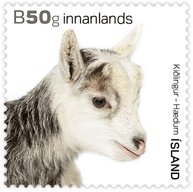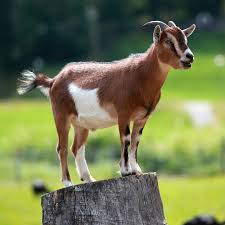Stamp: Goat (Capra aegagrus hircus) (Iceland 2017)
Goat (Capra aegagrus hircus) (Iceland 2017)
27 April (Iceland ) within release Animals (Fauna) goes into circulation Stamp Goat (Capra aegagrus hircus) face value 180 Icelandic króna
| Stamp Goat (Capra aegagrus hircus) in catalogues | |
|---|---|
| Michel: | Mi: IS 1529 |
Stamp is square format.
The young of Iceland’s domestic animals and pets will be featured on a stamp series which Postphil plans to issue in the near future. Spring is the most interesting time in the countryside and also in Reykjavík Park and Zoo, where new life arrives with joy and bustle. The baby kids in the Zoo are often the first arrivals. They are fun and lively, great favourites with both children and adult visitors. The first Icelandic settlers brought goats to Iceland, and all the goats now in the country are descended from them. Icelandic goats are on the list of endangered speciesAlso in the issue Animals (Fauna):
- Stamp - Goat (Capra aegagrus hircus) face value 180;
- Stamp - Domestic Cat (Felis silvestris catus) face value 195;
Stamp Goat (Capra aegagrus hircus) it reflects the thematic directions:
Animals are multicellular, eukaryotic organisms of the kingdom Animalia (also called Metazoa). All animals are motile, meaning they can move spontaneously and independently, at some point in their lives. Their body plan eventually becomes fixed as they develop, although some undergo a process of metamorphosis later on in their lives. All animals are heterotrophs: they must ingest other organisms or their products for sustenance.
The goat or domestic goat (Capra hircus) is a species of domesticated goat-antelope that is mostly kept as livestock. It was domesticated from the bezoar ibex (C. aegagrus aegagrus) of Southwest Asia and Eastern Europe. The goat is a member of the family Bovidae, meaning it is closely related to the sheep. There are over 300 distinct breeds of goat. It is one of the oldest domesticated species of animal - according to archaeological evidence its earliest domestication occurred in Iran at 10,000 calibrated calendar years ago
A juvenile is an individual organism (especially an animal) that has not yet reached its adult form, sexual maturity or size. Juveniles can look very different from the adult form, particularly in colour, and may not fill the same niche as the adult form. In many organisms the juvenile has a different name from the adult (see List of animal names).
Mammals are any vertebrates within the class Mammalia (/məˈmeɪli.ə/ from Latin mamma "breast"), a clade of endothermic amniotes distinguished from reptiles (including birds) by the possession of a neocortex (a region of the brain), hair, three middle ear bones and mammary glands. All female mammals nurse their young with milk, secreted from the mammary glands. Mammals include the largest animals on the planet, the great whales. The basic body type is a terrestrial quadruped, but some mammals are adapted for life at sea, in the air, in trees, underground or on two legs. The largest group of mammals, the placentals, have a placenta, which enables the feeding of the fetus during gestation. Mammals range in size from the 30–40 mm (1.2–1.6 in) bumblebee bat to the 30-meter (98 ft) blue whale. With the exception of the five species of monotreme (egg-laying mammals), all modern mammals give birth to live young. Most mammals, including the six most species-rich orders, belong to the placental group. The largest orders are the rodents, bats and Soricomorpha (shrews and allies). The next three biggest orders, depending on the biological classification scheme used, are the Primates (apes and monkeys), the Cetartiodactyla (whales and even-toed ungulates), and the Carnivora (cats, dogs, seals, and allies).




